Steam Deck has quietly become a reasonably capable ray tracing handheld
And the Asus ROG Ally is even better.
Valve's Steam Deck is a highly capable piece of kit, often reaching parity with last-gen consoles at ~720p, while more demanding current-gen efforts can prove quite playable as well - even including some of the top-end Unreal Engine 5 titles. The RDNA2 graphics hardware inside the Deck is even capable of ray tracing, though this support has largely been dormant in SteamOS. That's started to change over the last year, with first Vulkan and then DXR-enabled titles running under Proton with RT enabled - and RT performance has seen big boosts as well.
Today we're taking a look at the state of play when it comes to RT on Steam Deck, looking at some of the best-looking PC titles to see whether they can be playable with RT engaged. Can we get good frame-rates even with demanding ray tracing settings? And how does the Valve's handheld compare in performance terms against the more powerful ROG Ally?
The most obvious place to start is with the Steam Deck is some of the easier ray tracing workloads available - and I think Doom Eternal is a good first choice. The game runs well with minimal settings tweakery: 720p resolution, medium settings and RT toggled on. Relative to the non-RT version of the game, we get solid (if somewhat low-res and slightly ghostly) reflections on glossy surfaces, with very different material properties when RT is enabled. This makes for a transformative difference in scenes with glossy materials, though an aggressive roughness cutoff means that semi-gloss materials are largely bereft of RT treatment.
Performance takes an understandable hit with RT engaged, but at 30-50fps the game is still easily playable and should suit a 30fps cap on the Deck. That's a fascinating outcome, as Doom Eternal doesn't even feature RT on the Xbox Series S. Perhaps RAM limitations might have gotten in the way - keep in mind that the Steam Deck has 60 percent more RAM (!) than the somewhat memory-starved Series S - or perhaps the image quality hit was considered too impactful for the console. In any case, the Steam Deck is putting in a good result here, and scoring a feature-level win over a theoretically more powerful home console system.
Next up is Crysis 2 Remastered. This 2021 remaster of the 2011 classic features RT reflections on glossy surfaces. We're again using medium settings at 720p resolution here, with progressive increases in ray tracing fidelity translating to higher-res reflections traced against a more comprehensive BVH. The 'performance' setting is the best fit for our frame-rate target, with performance falling from the upper 50s with RT disabled to the mid-40s with it enabled. That's not a huge performance penalty then, and the game again outdoes the Series S which lacks RT entirely.
Control is our next title and a landmark early ray tracing benchmark. We're mostly pegged to the low settings preset here with medium RT enabled. Control is running at just 540p internally, but gets temporally upscaled to 720p by Remedy's proprietary TAAU technique to good effect. Control uses reflective surfaces heavily, so the visual improvement here is profound. We're going from a mix of SDF and SSR-based reflections to the full RT treatment across opaque and transparent glossy surfaces, which looks fantastic even five years after its initial release. Not to harp on this too much, but this is yet another game where Series S is raster-only, with the same awkward compromises that we don't have to deal with on Steam Deck.
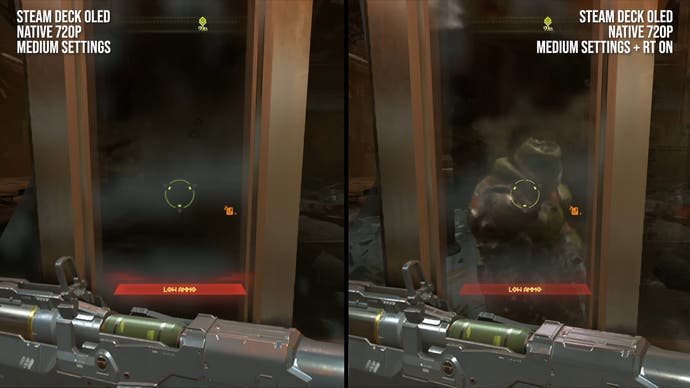
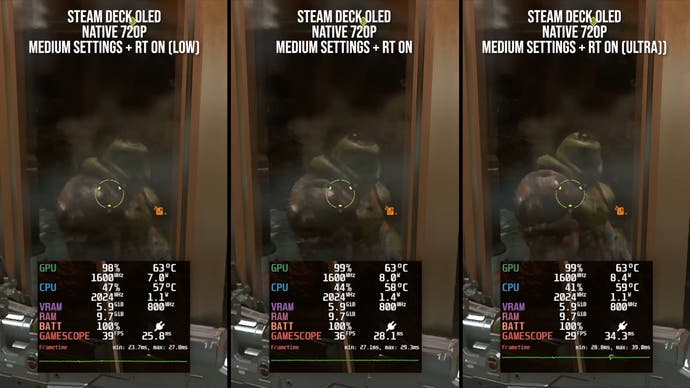
Performance starts off strong - 30-40fps in the early game - but the game sees more complex environments as we continue, so performance drops into the 20s later on. The game still largely runs well, but these moments did detract quite a bit from the experience.
We see a similar performance pattern in Persona 3 Reload. This recent release makes significant use of RT reflections, and the Steam Deck mostly acquits itself quite well, with performance often at or near 60fps. Unfortunately, the Deck struggles mightily when subjected to some of the game's heavier RT workloads in city areas, with severe performance dips.
Cyberpunk 2077 sees some of the same harsh performance issues. The default configuration is adept, with a 50-60fps readout at low settings, FSR 2 performance and RT disabled, but engaged RT flattens performance into the mid teens. Surprisingly, the full path tracing experience technically runs on the Steam Deck... though frame-rates are in slideshow territory at just 2-3fps. It's a fascinating and oddly compelling little demo, but we're nowhere near acceptable performance here.
Rounding out the SteamOS games today, we have Metro Exodus Enhanced Edition, where I've targeted low settings with medium RT - specifically RTGI. The key concession here is resolution, which I pegged to just 960x600 to boost frame-rates as much as possible. With those options the game largely runs above 30fps, but I'd imagine some later sections such as the demanding Taiga level would produce deeper lows. Weirdly, there's an issue with this game on SteamOS at the moment where the game seems oddly faded, which I couldn't correct and does detract from the experience somewhat.
That's the Steam Deck accounted for - but what about its more powerful portable counterpart, the Asus ROG Ally? This Windows 11 handheld packs a larger CPU and GPU configuration, alongside high-wattage TDP modes, to hopefully enable better RT performance - so it's worth seeing how it measures up.
Let's start with Crysis 2 Remastered. In the 15W mode in this shot, we get the typical mild uplift over Steam Deck, with a 24 percent uplift in performance. And if I dial the system up to its full 30W power, we get a 50 percent performance increase, which is about par for the course for the Ally. But if we get a face-full of RT, the Steam Deck falls a lot further behind, with the Ally 38 percent faster here in its performance mode. Note that I did have the Ally plugged in for these tests, which can increase the performance of the device relative to battery operation in some instances.
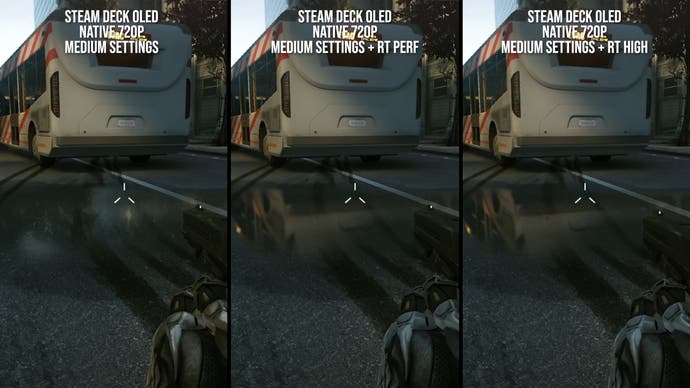
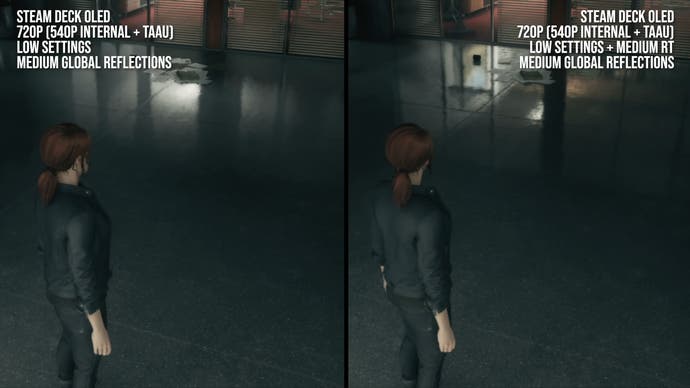
In Metro Exodus Enhanced Edition, we're getting about 31fps on the Ally versus 26fps on Steam Deck. But again, different scenes produce different results, with the Ally roughly 70 percent faster at some points - and a whopping 140 percent faster when we step up to 30W.
We do tend to see a lot of variance on the ROG Ally relative to the Steam Deck, so I was curious whether shifting the Deck over to Windows could help explain some of the discrepancies. Unfortunately, I came away from Windows testing more confused than anything.
With the Deck running SteamOS, we can hit frame-rates in the 30s in Crysis 2 Remastered with high RT, and in the teens with RT reflections in Cyberpunk 2077. Not a great outcome, but basically as expected from the testing so far. If we switch to Windows, performance in Crysis 2 actually gets a big haircut, with much worse performance than in SteamOS... but Cyberpunk gets a pretty substantial frame-rate boost, so it does seem like there's a lot of per-game variance. (Note that I conducted these tests with the VRAM allocation bumped to 4GB to maximise performance, and on the Steam Deck LCD - as the Deck OLED drivers for Windows aren't really in a usable state at the moment.)
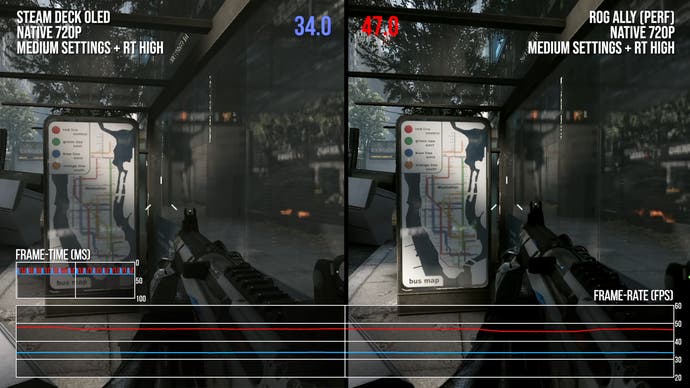

Switching back to the Ally, you can run RT games with decent performance, especially if you tune the system to hit turbo frequencies. I managed to squeeze a pretty solid 60fps out of Persona 3 Reload for instance, with max settings at 720p, while Metro Exodus Enhanced Edition ran well at 720p medium - often 40-50fps. This is a great result, considering how visually advanced this game is, and well in excess of what the Steam Deck can deliver.
Finally, I decided to give the ROG Ally a shot at running two of the most graphically ambitious PC titles: Alan Wake 2 and Avatar: Frontiers of Pandora. Both of these games prominently feature ray tracing features and tend to look their best on powerful desktop PCs rather than low-wattage PC handhelds, so I expected a stiff challenge.
Unfortunately, Alan Wake 2 doesn't deliver a very good result at all - even set to the low quality preset with low RT at 720p with FSR 2 performance. Initially, the game seems to struggle resolving a proper FSR 2 image for some reason, with a highly pixelated and noisy onscreen result. Eventually, the game does settle down a bit, but we're in 20fps territory in the town area, which is generally one of the less intense areas of the game. We do get RT shadows and RT reflections in the mix, but the boundary-pushing visuals aren't matched with solid performance. I am using the Ally's turbo mode here as well, but that's just not enough it seems.
Avatar fares a good deal better. Again, we're using the low settings preset, but I opted to target 720p with TAA as the game won't go below 720p internally with any reconstruction option. On the surface, the results don't look bad: we're clocking in at ~30fps and the game looks excellent, despite an obvious decrease to environmental detail. The problem is that the average frame-rate is let down by fairly frequent stutters during open-world traversal on the Ally, which disrupt the flow of gameplay. Avatar's RTGI and RT reflections are tantalising, but truly stable performance is elusive. I did try bumping up the VRAM allocation from 4GB to 6GB and then 8GB to see if that would fix things, but it did not.
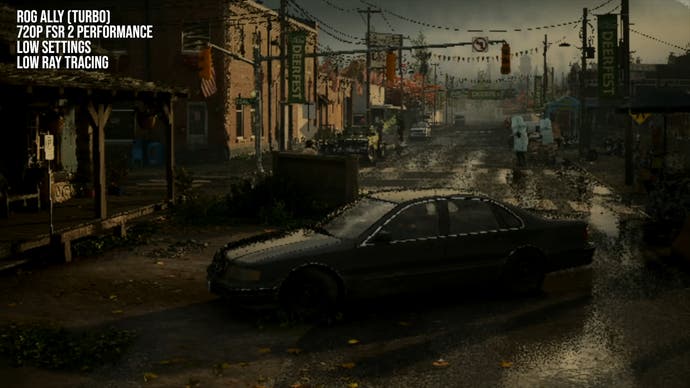
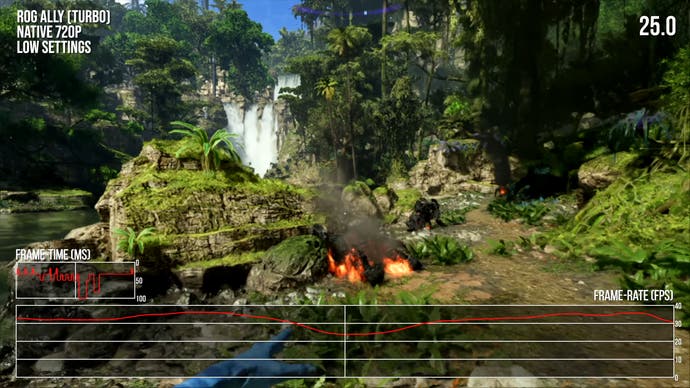
The Steam Deck is indeed capable of running games with ray tracing enabled in SteamOS, and manages to hit decent performance figures in games with relatively light RT workloads like Doom Eternal, Crysis 2 Remastered and Persona 3 Reload - even Metro Exodus Enhanced Edition scores a playable result. Other titles can cause the device to really suffer, and not always the games that you'd expect to prove the most challenging. The ROG Ally is significantly faster than the Deck with RT enabled, provided you stick to the Ally's higher-end power modes. Still, there are limits, with Alan Wake 2 and Avatar not delivering a great experience when RT is enabled.
Of course, this is somewhat of an academic exercise. In the interest of portable battery life, and of performance more generally, I'd probably stay away from RT-centric titles across the range of currently available gaming portables. Current-gen consoles aren't exactly known for their RT prowess, but even the Xbox Series S is much more capable - and benefits from tweaks and optimisations that don't always translate to lower-end PC hardware.
By and large then, the current crop of gaming handhelds are calibrated towards eighth-gen console games and titles targeting similar or weaker specs, not for the hardest-hitting showcases of current-gen technology. Titles that use RT are a bit hit-or-miss here, and users may want to optimise for higher-performing, battery-sparing experiences instead. But for those that do want to experience a touch of boundary-pushing tech on portable hardware, you can indeed run ray tracing experiences on handheld devices - just keep your expectations in check.


